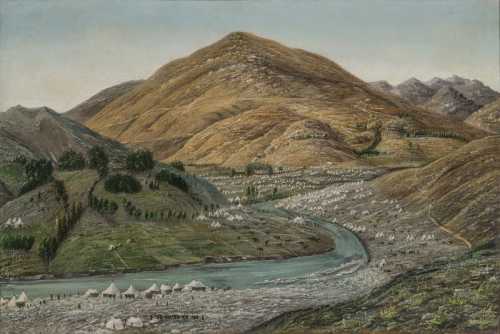About Ghaffari (Kamal Ol Molk) Mohammad
Mohammad Ghaffari, also known as Kamal-ol-Molk, is considered to be the most famous Iranian artist. Mohammad Ghaffari's importance extends beyond his paintings in that he established a kind of academic art at the court of Naser al-Din Shah based on the ground laid by Mozyan-o-Doleh and other figures. In order to spread academic art thought to Iran's art scene, he established the Sanaye Mostazrafeh Art School. As a legacy of Renaissance and Baroque artists, it was a form of academic art taught in European academies. However, it reduced all of the values and standards of naturalism to masterful craftsmanship. There was no place for expressive interpretation of nature in this type of naturalism. From the very beginning, Mohammad Ghaffari was fascinated by this type of art. For this reason, he experimented more in this direction than his contemporaries, even though he considered himself to be a follower of masters such as Raphael and Rembrandt.
Ghaffari began his art education at Dar-ul-Funun under the guidance of Mozayan o-Doleh. When Naser al-Din Shah visited this school, he was impressed with his work and invited him to the court. Soon, he was given the title of court painter and court waiter (Pishkhedmate Hozour-e-Homayouni) by the king (1881). In recognition of his continuous activity as a court painter and Shah's teacher, he was nicknamed Kamal-ol-Molk. His painting of the Hall of Mirrors was one of his most significant works during this period. Kamal-ol-Molk moved to Europe to study after Naser al-Din Shah was assassinated (1897). During the period 1900-1903, he spent more than three years in Florence, Rome, and Paris. The Baqdadi goldsmith, Falgir Yehudi, and Karbala Square were among the paintings he painted during his stay in Iraq. Although he was inclined toward constitutionalists (for example, the painting of Ali-Qoli Khan Bakhtiari [Sardar Asad] proves that), he did not actively participate in the constitutional movement. The following year, he founded Sanaye Mostazrafeh Art School and served as the head of the General Department of Mostazrafeh Industries (fine arts department). At the school mentioned, he worked very hard to train students, the most talented of whom ultimately became professors. Due to disagreements with the minister of education regarding the school's independence, he resigned from teaching and moved to his private property in Neyshabur in 1921. In his native country, he became blind in one eye as a result of an accident, but he continued to paint until the end of his life.
The artist Kamal-ol-Molk departed from the tradition of Iranian painting and turned to pure naturalism. Some of the two-dimensional and decorative elements in his early works (such as Tekiyeh Dowlat) were more a result of his limited proficiency in three-dimensional techniques rather than an attempt to combine Iranian and European painting techniques. As a result of Iran's two-hundred-year foreignization history, Sanayeh al-Molk's new arrival from Europe, the prevalence of photography in Iran, and the spirit of imitation of western phenomena in the Naser al-Din Shah court, it was logical for Kamal al-Molk to possess such a strong tendency.
The Most Expensive Artwork
At Auctions
First Attendance
29 May 2015
# Attendance
5
# Artworks
5
Average Realized Price
143,093 USD
Average Min Estimate
83,796 USD
Average Max Estimate
113,530 USD
Sell-through Rate
100%
Average Growth of Artwork Worth
55.086%
Timeline
Landscape Plateau exhibition
13 December
The 9th Tehran- Classic and Modern Iranian Art auction
29 June
هفتمین دوره حراج تهران auction
7 July
پنجمین دوره حراج تهران auction
27 May
Art of the Islamic & Indian Worlds auction
21 April
چهارمین دوره حراج تهران auction
29 May
